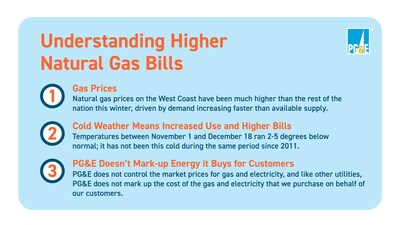PG&E Working to Support Customers from the Impacts of Increased Energy Costs Due to Higher Cost of Gas and Colder Temperatures
Rhea-AI Summary
Pacific Gas and Electric Company (NYSE: PCG) reports a significant increase in energy bills for customers this winter, largely attributed to rising natural gas prices and unusually cold temperatures. From November to March, PG&E anticipates residential bills to rise by 32% compared to last winter. California's gas prices have been five times higher than national benchmarks, driven by increased demand and low supply. In response, PG&E supports the California Public Utilities Commission's initiative to issue the annual Climate Credit early to provide relief. The company is also implementing strategies to mitigate costs for customers and ensure long-term price stability.
Positive
- California's Public Utilities Commission voting on early Climate Credit could provide financial relief to customers.
- PG&E supports initiatives to stabilize customer bills and offset energy costs.
- Efforts to generate revenue through licensing agreements and operational improvements, like undergrounding powerlines.
Negative
- Residential energy bills expected to be 32% higher from November to March compared to last year.
- Natural gas prices in California significantly above national averages, impacting customer bills.
- Colder-than-normal temperatures leading to increased energy demand.
News Market Reaction 1 Alert
On the day this news was published, PCG gained 0.32%, reflecting a mild positive market reaction.
Data tracked by StockTitan Argus on the day of publication.
The increased cost of natural gas on the
Like other utility companies,
As of
Why natural gas prices are up
Natural gas prices change daily and have been much higher on the
Colder temperatures in the West have caused customers to turn up the thermostat and use more energy.
Bill relief from California Climate Credit
The
Separately, more than 300,000 customers who experienced financial hardships during the pandemic will receive an automatic one-time bill credit before
How
- Accessing the lowest-priced gas from three gas production basins.
- Withdrawing gas from underground gas storage when demand and prices increase.
- Using financial hedging products to lock in lower prices.
Here are three tools that customers can use now to manage winter bills:
- Keep bills predictable. Level out monthly payments and offset high seasonal bills with Budget Billing, a free tool that averages your annual energy costs to help manage monthly bills.
- Flexible payment arrangements. Extend your bill due date or make a payment arrangement. Access your online account for details.
- Customers may also qualify for financial assistance programs including the
Low-Income Home Energy Assistance Program (LIHEAP), a federally-funded assistance program overseen by the state that offers one-time residential utility bill payment.
Here are three ways customers can lower energy use to save money:
- Dial down your thermostat. You can save about
2% of your heating bill for each degree that you lower the thermostat (if the turndown lasts a good part of the day or night). Turning down from 70 to 65 degrees, for example, saves about10% . - Lower your water heater temperature. By setting your water heater temperature to 120 degrees Fahrenheit you can reduce the amount of energy it takes to produce and maintain hot water.
- Keep areas around vents open. Furniture and carpet can block heating vents, which makes heating systems work harder and prevents rooms from heating quickly.
About
![]() View original content to download multimedia:https://www.prnewswire.com/news-releases/pge-working-to-support-customers-from-the-impacts-of-increased-energy-costs-due-to-higher-cost-of-gas-and-colder-temperatures-301735293.html
View original content to download multimedia:https://www.prnewswire.com/news-releases/pge-working-to-support-customers-from-the-impacts-of-increased-energy-costs-due-to-higher-cost-of-gas-and-colder-temperatures-301735293.html
SOURCE









